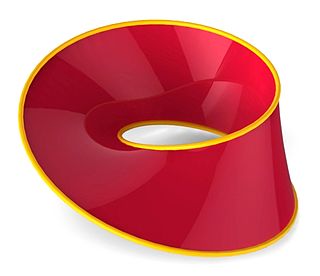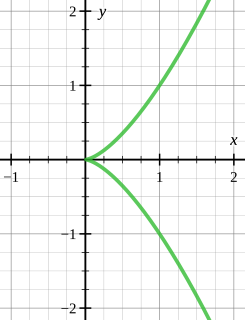
A sphere is a perfectly round geometrical object in three-dimensional space that is the surface of a completely round ball.

A Möbius strip, Möbius band, or Möbius loop, also spelled Mobius or Moebius, is a surface with only one side and only one boundary. The Möbius strip has the mathematical property of being unorientable. It can be realized as a ruled surface. Its discovery is attributed to the German mathematicians Johann Benedict Listing and then independently August Ferdinand Möbius in 1858, though a structure similar to the Möbius strip can be seen in Roman mosaics dated circa 200–250 AD.

In mathematics, hyperbolic geometry is a non-Euclidean geometry. The parallel postulate of Euclidean geometry is replaced with:

Gauss's Theorema Egregium is a major result of differential geometry proved by Carl Friedrich Gauss that concerns the curvature of surfaces. The theorem is that Gaussian curvature can be determined entirely by measuring angles, distances and their rates on a surface, without reference to the particular manner in which the surface is embedded in the ambient 3-dimensional Euclidean space. In other words, the Gaussian curvature of a surface does not change if one bends the surface without stretching it. Thus the Gaussian curvature is an intrinsic invariant of a surface.

In differential geometry, the Gaussian curvature or Gauss curvatureΚ of a surface at a point is the product of the principal curvatures, κ1 and κ2, at the given point:

In mathematics, a hyperbolic space is a homogeneous space that has a constant negative curvature, where in this case the curvature is the sectional curvature. It is hyperbolic geometry in more than 2 dimensions, and is distinguished from Euclidean spaces with zero curvature that define the Euclidean geometry, and elliptic geometry that have a constant positive curvature.

In mathematics, the real projective plane is an example of a compact non-orientable two-dimensional manifold; in other words, a one-sided surface. It cannot be embedded in standard three-dimensional space without intersecting itself. It has basic applications to geometry, since the common construction of the real projective plane is as the space of lines in R3 passing through the origin.

The helicoid, after the plane and the catenoid, is the third minimal surface to be known.

In mathematics, the monkey saddle is the surface defined by the equation
In the differential geometry of surfaces, an asymptotic curve is a curve always tangent to an asymptotic direction of the surface. It is sometimes called an asymptotic line, although it need not be a line.

In mathematics, an Apollonian gasket or Apollonian net is a fractal generated starting from a triple of circles, each tangent to the other two, and successively filling in more circles, each tangent to another three. It is named after Greek mathematician Apollonius of Perga.
In geometry, a vertex is a point where two or more curves, lines, or edges meet. As a consequence of this definition, the point where two lines meet to form an angle and the corners of polygons and polyhedra are vertices.

In mathematics, the differential geometry of surfaces deals with the differential geometry of smooth surfaces with various additional structures, most often, a Riemannian metric. Surfaces have been extensively studied from various perspectives: extrinsically, relating to their embedding in Euclidean space and intrinsically, reflecting their properties determined solely by the distance within the surface as measured along curves on the surface. One of the fundamental concepts investigated is the Gaussian curvature, first studied in depth by Carl Friedrich Gauss, who showed that curvature was an intrinsic property of a surface, independent of its isometric embedding in Euclidean space.
In differential geometry, the Carathéodory conjecture is a mathematical conjecture attributed to Constantin Carathéodory by Hans Ludwig Hamburger in a session of the Berlin Mathematical Society in 1924. Carathéodory did publish a paper on a related subject, but never committed the Conjecture into writing. In, John Edensor Littlewood mentions the Conjecture and Hamburger's contribution as an example of a mathematical claim that is easy to state but difficult to prove. Dirk Struik describes in the formal analogy of the Conjecture with the Four Vertex Theorem for plane curves. Modern references to the Conjecture are the problem list of Shing-Tung Yau, the books of Marcel Berger, as well as the books.

In mathematics, a conic section is a curve obtained as the intersection of the surface of a cone with a plane. The three types of conic section are the hyperbola, the parabola, and the ellipse; the circle is a special case of the ellipse, though historically it was sometimes called a fourth type. The ancient Greek mathematicians studied conic sections, culminating around 200 BC with Apollonius of Perga's systematic work on their properties.

The study of geodesics on an ellipsoid arose in connection with geodesy specifically with the solution of triangulation networks. The figure of the Earth is well approximated by an oblate ellipsoid, a slightly flattened sphere. A geodesic is the shortest path between two points on a curved surface, analogous to a straight line on a plane surface. The solution of a triangulation network on an ellipsoid is therefore a set of exercises in spheroidal trigonometry.
In astronomy, geography, and related sciences and contexts, a direction or plane passing by a given point is said to be vertical if it contains the local gravity direction at that point. Conversely, a direction or plane is said to be horizontal if it is perpendicular to the vertical direction. In general, something that is vertical can be drawn from up to down, such as the y-axis in the Cartesian coordinate system.



















